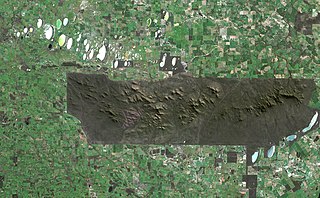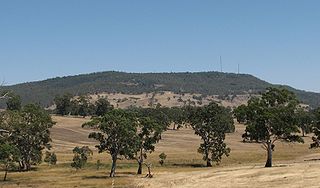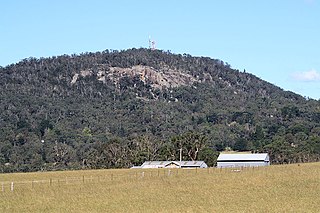
Porongurup National Park is a national park in the Great Southern region of Western Australia. It covers 26.21 square kilometres (10.12 sq mi), and is 360 kilometres (220 mi) southeast of Perth and 40 kilometres (25 mi) north of Albany.

Stirling Range National Park is a national park in the Great Southern region of Western Australia, approximately 337 kilometres (209 mi) south-east of Perth.

The Murchison River is the second longest river in Western Australia. It flows for about 820 km (510 mi) from the southern edge of the Robinson Ranges to the Indian Ocean at Kalbarri. The Murchison-Yalgar-Hope river system is the longest river system in Western Australia. It has a mean annual flow of 208 gigalitres, although in 2006, the peak year on record since 1967, flow was 1,806 gigalitres.

Mount Barker is a town and locality on Albany Highway and the administrative centre of the Shire of Plantagenet in the Great Southern region of Western Australia. At the 2021 census, Mount Barker had a population of 2,855.

Porongurup is a locality in the Shire of Plantagenet, Great Southern region of Western Australia. At the 2006 census, Porongurup had a population of 370. The name is derived from the Aboriginal place-name, and consequently arrived with no spelling as such. A common alternate spelling is Porongorup and while some maps still show this spelling, state government signs around the town use "Porongurup", as does the promotion association for the region.

The Stirling Range or Koikyennuruff is a range of mountains and hills in the Great Southern region of Western Australia, 337 kilometres (209 mi) south-east of Perth. It is over 60 kilometres (37 mi) wide from west to east, stretching from the highway between Mount Barker and Cranbrook eastward past Gnowangerup. The Stirling Range is protected by the Stirling Range National Park, which was gazetted in 1913, and has an area of 1,159 km2 (447 sq mi).

The town of Hyden is located 292 kilometres (181 mi) east-southeast of Perth, Western Australia in the Shire of Kondinin. Hyden is home to Wave Rock, Mulka's Cave and Hippos Yawn, all popular local tourist attractions.

Seneca Rocks is a large crag and local landmark in Pendleton County in the Eastern Panhandle of West Virginia, United States. The south peak is the only peak inaccessible except by technical rock climbing techniques on the East Coast of the United States. One of the best-known scenic attractions in West Virginia, the sheer rock faces are a popular challenge for rock climbers.
Austin Downs Station or Austin Downs is a pastoral lease in the Mid West region of Western Australia.

Mount Alexander is a mountain located approximately 125 km north-west of Melbourne, near the town of Harcourt. It rises 350 metres above the surrounding area to a level of 744 metres above sea level. Being a prominent local landmark, the mountain has its name associated with the surrounding district once known as the Mount Alexander goldfields, and presently defined as the Shire of Mount Alexander, centred on Castlemaine. Most of the mountain is included within the boundaries of the Mount Alexander Regional Park managed by Parks Victoria. The Djadjawurrung name for the mountain is Lanjanuc.

Chippers Leap, formerly known as Chipper's Leap, is a granite outcrop on Greenmount Hill in Perth, Western Australia. It is located at 31º54'S 116º04'E, on the northern side of Great Eastern Highway, near the border between the suburbs of Swan View and Greenmount.

Mount Gibraltar is a mountain with an elevation of 863 metres (2,831 ft) AHD that is located in the Southern Highlands region, between Bowral and Mittagong, in New South Wales, Australia. Further west is Berrima.
Granite outcrops of Western Australia are weathered landforms that occur throughout the state of Western Australia, composed primarily of the rock type granite. All recognised types of this landform can be observed, commonly as bornhardts, but also as inselbergs, castle koppies and nubbins. Rising abruptly from the surrounding landscape they create a variety of microhabitats for plants, and provide seasonal resources and refuge for a range of animals. These areas thus have rich biodiversity and many endemic species. They are significant locations that tie in with the Aboriginal and European cultural heritage of Western Australia.

The Great Southern wine region is in Western Australia's Great Southern region. It comprises an area 200 kilometres (120 mi) from east to west and over 100 kilometres (62 mi) from north to south, and is Australia's largest wine region.

Gibraltar Peak is a mountain with an elevation of 1,038 metres AHD that is located within the Tidbinbilla Nature Reserve, approximately 26.4 kilometres from Canberra, in the Australian Capital Territory. Gibraltar Peak is the 45th highest mountain in the Australian Capital Territory. There are two tracks leading up to the summit of the mountain, the longer being 13 kilometres (8.1 mi) and the shorter being 8 kilometres (5.0 mi).

Boyagin Rock is located 10 km (6.2 mi) south west of Brookton and 26 km (16 mi) north west of Pingelly in the Wheatbelt region of Western Australia, which is approximately 175 km (109 mi) south east of Perth. The Boyagin Rock outcrop rises 50 m (160 ft) above the surrounding land and is an crestal area of a granite inselberg within the geological Yilgarn Craton framework.

William Grills Knight was a prominent businessman and politician who served as the mayor of Albany in the Great Southern region of Western Australia.

Acacia leioderma also commonly known as the Porongurup wattle is a species of wattle which is endemic to an area in the lower Great Southern region of Western Australia centered on Albany.
Bulga Downs Station is a pastoral lease that once operated as a sheep station but is now a cattle station located in the Mid West region of Western Australia.
Gnarlbine Rock is a granite rock located approximately 492 km (306 mi) east of Perth and approximately 30 km (19 mi) southwest of Coolgardie in the Goldfields-Esperance region of Western Australia. It is found within a 640-acre (260 ha) heritage listed reserve.

















